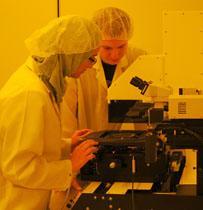
Bioengineers break new ground in water safety detection
It’s amazing what a tiny drop of water can tell you when it finds itself in the right hands. For their senior design project, bioengineering seniors Sarah Ghanbari and Nick Giustini are fabricating a portable, fast, accurate, and user-friendly diagnostic device for use in remote areas that will detect the presence of pathogens in a tiny water sample without the need for expensive and bulky lab equipment.
“With more than one billion people in the world without access to potable water, and more than two million deaths each year due to water-borne diseases, this lab-on-a-chip can be an important tool for health management,” said Giustini.
“We’re basically starting from scratch, trouble-shooting the steps to design and fabricate a microfluidic device that integrates several complex laboratory functions onto a single chip,” said Ghanbari. Their new device incorporates a high-throughput concentrator, cell lysis chamber, and electrochemical DNA sensor. First, the concentrator sorts out target pathogens from the untreated water sample at a high-throughput, enabling a large volume of the sample to be processed even in a microscale device. Then, cells are thermally lysed to expose their DNA, and last, the DNA is directed to the sequence-specific electrochemical sensor.
Though they had a basic idea of how their device would look when they started out, the pair acknowledges that the project has evolved greatly over the past year. “It’s a big responsibility to make a device that is both rugged enough and easy enough to use in the field, while also figuring out how complex it should be. You have to consider whether each component you want to add is really necessary,” said Giustini, who plans to go on to medical school after graduation.
Next year, Ghanbari will continue working with their advisor, Assistant Professor Ashley Kim, and she’s already spoken with some junior bioengineering students about continuing work on the project. “Microfluidics is the new big thing happening in bioengineering now. Many people in third world countries need help; we’re addressing an entire population that’s been neglected,” she said.